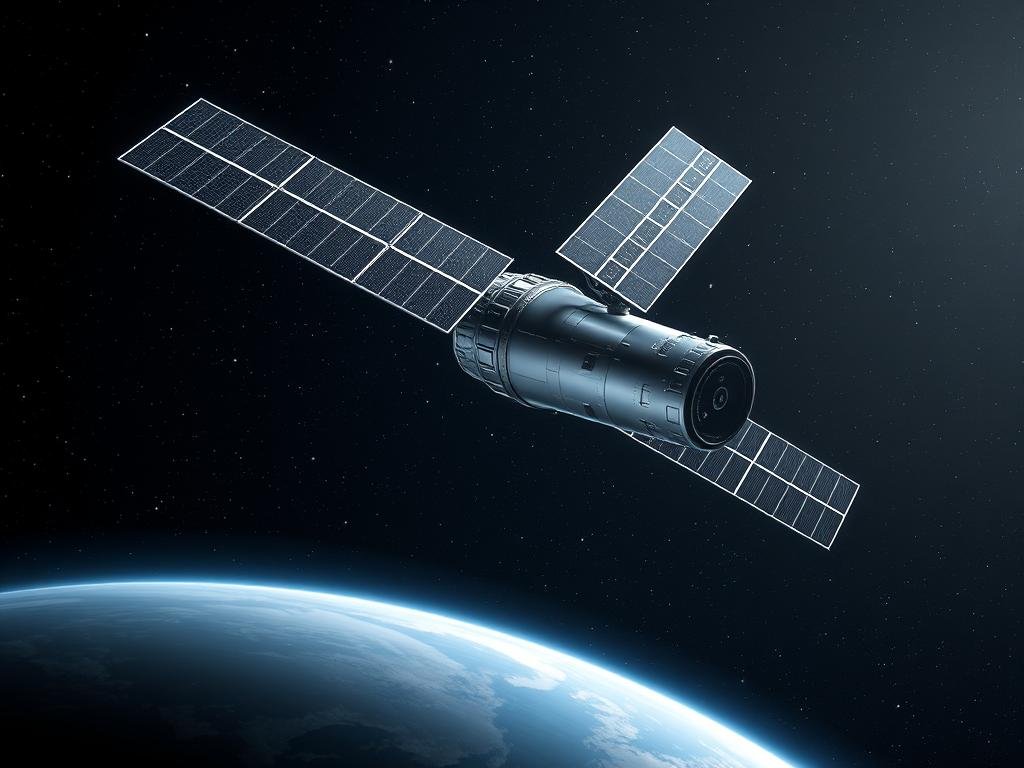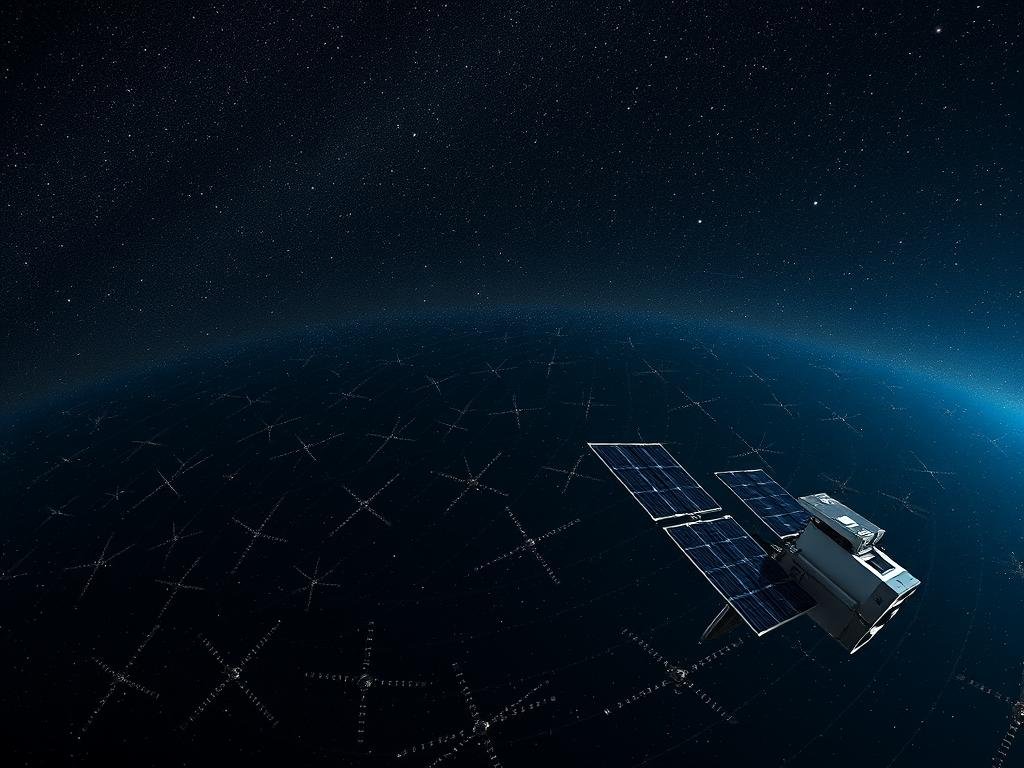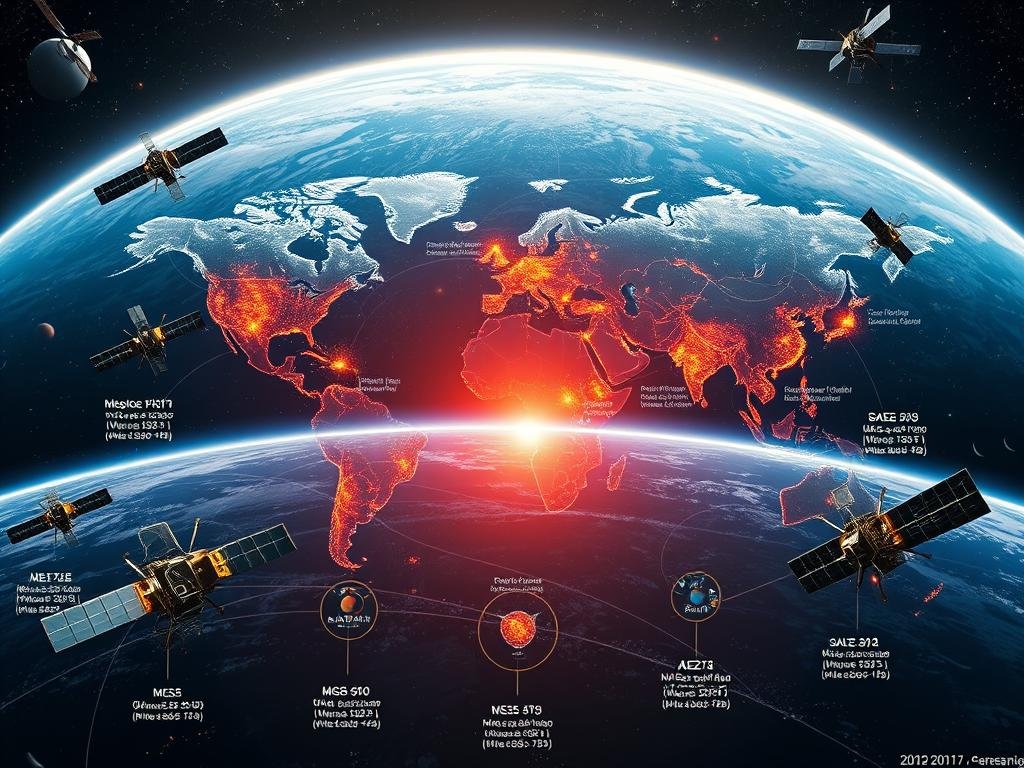The world of satellite internet is changing fast. With over 7,135 satellites launched and plans for 42,000 satellites, we’re getting closer to internet for everyone.
A big competition is happening in satellite internet. Companies like Project Kuiper (Amazon) and OneWeb are racing against SpaceX’s Starlink. They all want to bring global internet access and fast connections to us all.
Key Takeaways
- The satellite internet market is growing fast, with many players joining in.
- Project Kuiper (Amazon) and OneWeb are big rivals to Starlink in satellite internet.
- The race for global satellite internet aims for internet for all and fast speeds.
- Space technology advancements are key for better satellite internet.
- Global satellite internet will greatly change how we connect and communicate.
The New Space Race: Satellite Internet Revolution
A new era in internet connectivity is starting, with satellite internet leading the way. It promises to close the digital gap. With technology improving, satellite internet is now a strong option for connecting the world. It offers faster speeds and lower latency than before.
How Satellite Internet Is Changing Global Connectivity
Satellite internet is changing how we connect globally. Low Earth orbit (LEO) satellites make internet access easier, even in hard-to-reach places. For example, Starlink’s Direct-to-Cell (DTC) tech is being used on 234 satellites. It covers 500,000 square miles of U.S. dead zones.
This move is a big step towards making internet available worldwide.
The benefits of satellite internet include:
- Faster speeds: LEO satellites reduce latency, making internet more responsive.
- Broader coverage: Satellite internet can reach remote and rural areas where traditional infrastructure is lacking.
- Reliability: Satellite internet is less susceptible to physical damage from natural disasters compared to traditional cable-based internet.
The Shift from Traditional Internet Infrastructure
The move to satellite internet is driven by the need for global connectivity. Traditional internet often can’t reach remote areas, leaving them offline. Satellite internet offers a solution, providing fast and efficient access.
A comparison of traditional internet infrastructure and satellite internet shows the benefits of the latter:
| Feature | Traditional Internet | Satellite Internet |
|---|---|---|
| Coverage | Limited in rural areas | Global, including remote areas |
| Speed | Varies, often slower in rural areas | Faster with LEO technology |
| Latency | Generally lower | Improving with LEO satellites |
| Reliability | Susceptible to physical damage | Less susceptible to natural disasters |
As the world moves towards greater connectivity, satellite internet is key. Understanding its benefits and challenges helps us see its role in changing global connectivity.
Understanding Starlink: SpaceX’s Internet Constellation
SpaceX’s Starlink is changing how we connect online. It uses a network of satellites to bring fast internet to places without it. Now, you can get high-speed internet almost anywhere, thanks to Starlink’s satellite constellation.
Technology and Infrastructure
Starlink uses a group of Low Earth Orbit (LEO) satellites. These satellites are much closer to Earth than usual satellites. This close orbit means Starlink offers faster speeds and lower delays.
The setup includes ground stations and user terminals. These terminals, or “dishes,” are small and easy to set up. Ground stations help the satellites talk to the internet.

Current Coverage, Speeds, and Pricing
Starlink is now in over 100 countries. It’s getting bigger as more satellites are launched. Speeds range from 50 Mbps to 150 Mbps, with some users getting over 200 Mbps. Delays are usually 20-40 ms.
Getting started with Starlink costs $599 for the hardware and $110 a month. It’s a big help for places with no internet, giving them a fast and reliable connection.
| Feature | Starlink | Traditional Satellite Internet |
|---|---|---|
| Latency | 20-40 ms | 600-800 ms |
| Download Speeds | 50-150 Mbps | 25-100 Mbps |
| Upload Speeds | 5-20 Mbps | 3-10 Mbps |
| Global Coverage | 100+ countries | Limited by satellite footprint |
Market Position and Growth
Starlink has over 2.3 million subscribers. It’s a big name in satellite internet, helping rural areas get online. SpaceX is adding more satellites and improving the network, ready for more growth.
Other companies like Amazon’s Project Kuiper and OneWeb are joining the race. But Starlink’s early start and constant updates keep it ahead. As more people need internet everywhere, Starlink is ready to serve.
Amazon’s Project Kuiper: The Retail Giant Enters Space
Amazon’s Project Kuiper has entered the race for global satellite internet. As a tech giant, Amazon is using its resources to challenge other providers. This move is set to shake up the satellite internet world.

Development Status and Goals
Amazon’s Project Kuiper aims to bring global satellite broadband to everyone. It plans to launch 3,236 satellites by 2029. This shows Amazon’s big plans for internet access worldwide. For more on Project Kuiper, check out CNET’s explanation.
The project is moving fast, with Amazon already starting to launch its satellites. Amazon wants to give fast, reliable internet to places that need it most.
Technical Specifications and Planned Coverage
Project Kuiper’s tech is set to offer fast speeds and wide coverage. The satellites will orbit the Earth at a low height. This will cut down on delays and make the internet better.
- Satellite Constellation: 3,236 satellites planned
- Orbit: Low Earth Orbit (LEO)
- Coverage: Global, with a focus on underserved areas
- Speed: High-speed broadband
Amazon’s Competitive Advantages in the Market
Amazon has several advantages in the satellite internet market with Project Kuiper. These include:
- Existing Infrastructure: Amazon’s strong logistics and setup can help with making and launching satellites.
- Technical Expertise: Amazon’s teams know how to handle big projects. This skill will help with satellite tech.
- Customer Base: Amazon has a huge customer base. This could help Project Kuiper grow fast.
With these strengths, Amazon is ready to make a big splash in satellite internet. As Project Kuiper grows, it will likely play a key role in the future of global internet.
OneWeb: The Phoenix Rising from Bankruptcy
OneWeb’s story is one of resilience. It has risen from bankruptcy to offer internet solutions to rural areas. Despite financial hurdles, OneWeb has made a strong comeback. It’s driven by its goal to provide global satellite internet.

Journey and Current Status
OneWeb started with big plans for a low earth orbit (LEO) satellite network. It launched over 1,200 satellites but faced financial troubles. Now, under new leadership, OneWeb is rebuilding its network and improving its satellite internet provider services.
Experts say OneWeb’s comeback is a big deal for satellite internet. They see great promise in its future. For more, check out insights from industry experts.
“OneWeb’s recovery shows the satellite industry’s strength,” said a top analyst. “Their work on LEO satellites for global connectivity is impressive.”
Technology Approach and Satellite Architecture
OneWeb uses LEO satellites for fast and reliable internet. These satellites are closer to Earth, which means less delay. This makes them perfect for rural internet solutions.
OneWeb’s satellites can grow with the network. This makes it easy to manage and expand the service.
- LEO satellite constellation for reduced latency
- Scalable network architecture for flexible expansion
- Advanced satellite technology for reliable connectivity
Target Markets and Business Strategy
OneWeb aims to reach rural and remote areas without good internet. It works with local providers to offer oneweb internet. This way, OneWeb helps bring quality internet to places that need it most.
As OneWeb grows and improves its network, it’s set to be a big name in satellite internet. Its strong technology and smart business plan will make a big difference.
Other Key Players in the Satellite Internet Race
Names like Starlink and OneWeb are well-known in satellite internet. But, other big players are also making their presence felt. The race is getting fiercer as new tech comes out and old players adjust to new needs.
Telesat Lightspeed
Telesat is working on Lightspeed, a network of satellites in low Earth orbit. It aims to offer fast, reliable internet worldwide. Telesat Lightspeed plans to use cutting-edge tech to beat other satellite networks in speed and latency.
Telesat Lightspeed’s main features are:
- Advanced LEO architecture for reduced latency
- High-speed internet for both home users and businesses
- Global coverage, focusing on hard-to-reach areas

AST SpaceMobile
AST SpaceMobile is creating a network that connects directly to cell phones. This means you can get broadband internet without special devices. A report on satellite internet competition highlights the importance of such innovations for more internet access.
AST SpaceMobile’s tech offers:
- Better mobile coverage in rural and remote places
- Smooth integration with current cell networks
- Global reach without extra infrastructure
Traditional Satellite Providers Adapting: Viasat and HughesNet
Viasat and HughesNet are updating their services to keep up with demand. They might not be as new as LEO constellations, but they’re using their experience and networks to stay in the game.
These providers are focusing on:
- Improving their satellite tech for faster speeds and less delay
- Targeting specific markets where they already have a strong presence
- Looking for partnerships to boost their offerings
The satellite internet world is changing fast. The battle between newcomers like Telesat Lightspeed and AST SpaceMobile, and old hands like Viasat and HughesNet, will push for better services. When comparing these space internet providers, coverage, speed, and cost will be key to success.
Comparing Satellite Internet Technologies and Pricing
With many satellite internet providers now available, it’s important to understand their differences. The variety in technologies and pricing can be confusing. But, breaking down the key components can make it easier.
Low Earth Orbit (LEO) vs. Medium Earth Orbit (MEO) vs. Geostationary (GEO)
Satellite internet technologies are mainly categorized by the orbit of their satellites. LEO satellites, like those used by Starlink, orbit at about 550 km. They provide lower latency and higher speeds. On the other hand, GEO satellites orbit at around 36,000 km. They have higher latency but offer broader coverage with fewer satellites.
Speed and Coverage Comparisons
The differences in speed and coverage between LEO, MEO, and GEO satellites are clear. LEO constellations offer faster speeds and lower latency, making them great for real-time applications. For example, Starlink’s LEO satellites can provide speeds up to 150 Mbps with latency as low as 20 ms. GEO satellites, used by providers like Viasat, cover vast areas but have higher latency.
| Orbit Type | Typical Speed Range | Latency | Coverage Area |
|---|---|---|---|
| LEO | 50-200 Mbps | 20-40 ms | Regional |
| MEO | 20-100 Mbps | 100-150 ms | Regional to Global |
| GEO | 10-50 Mbps | 500-700 ms | Global |
Pricing Models and Affordability Analysis
Pricing is a key factor in choosing a satellite internet provider. Starlink’s pricing starts at $599 for the terminal, with monthly fees from $110 to $150. Other providers like HughesNet and Viasat have different pricing models. Costs vary based on data caps and speeds. For a detailed comparison, visit PCMag’s comparison of major providers.
Consumer Experience Reports
Consumer experiences vary across different satellite internet providers. Factors like installation complexity, customer support, and reliability are important. For example, some users find Starlink’s service reliable with good speeds. But, others have faced issues with latency and service interruptions. Reading consumer reviews can give valuable insights into what to expect from a provider.
Transforming Rural and Remote Connectivity
Satellite internet is now changing how we connect in rural and remote areas. The world is getting more digital, and everyone needs reliable internet. This is true, even in places that were left behind.
Bridging the Digital Divide in Rural America
Rural America has faced a big problem: not enough internet. This has slowed down growth and made it hard to get basic services. Satellite internet is now bringing high-speed connectivity to these areas.
Starlink is helping out in many remote and rural spots. It’s making life better and opening up new chances for businesses and communities.
Impact on Developing Nations and Remote Communities
Satellite internet is also changing lives in developing nations and remote communities. It’s giving them global internet access. This lets them join the global economy.
- Access to educational resources
- Improved healthcare services through telemedicine
- Enhanced economic opportunities through e-commerce
Case Studies: Real-world Applications in Isolated Areas
There are many stories of how satellite internet has made a difference. For example, in some African countries, it’s helped schools get online learning. This has really improved education.
| Location | Application | Impact |
|---|---|---|
| Rural USA | Business Operations | Improved productivity and connectivity |
| Remote Australia | Emergency Services | Enhanced communication during emergencies |
These stories show how satellite internet can change lives and boost economies in hard-to-reach places. It’s a key part of rural internet solutions.
Industry-Specific Applications and Regulatory Challenges
Satellite internet is more than just for home use. It’s key for industry-specific applications needing global coverage. It helps various sectors work better, save money, and boost efficiency.
Maritime and Aviation Connectivity Solutions
The maritime and aviation sectors greatly benefit from satellite internet. It keeps ships connected, giving them updates on navigation and weather. It also helps with crew welfare.
In aviation, it offers in-flight internet. This improves both passenger comfort and operational efficiency through real-time data.
Starlink is a top choice for maritime companies for its fast, reliable connection. Aviation companies also see its value for in-flight internet, boosting both passenger and operational management.
Emergency Services and Disaster Recovery
Satellite internet is vital for emergency services and disaster recovery. It’s a lifeline when traditional communication fails during disasters. It helps responders coordinate and keep in touch with isolated areas.
It’s also key for disaster preparedness and response. The quick setup of satellite internet in emergencies is a big plus, making it essential for emergency services.
Regulatory and Environmental Concerns
Despite its benefits, satellite internet faces regulatory challenges. One major issue is spectrum allocation. As more satellites launch, finding enough spectrum is essential. Regulators must manage this to avoid interference.
There are also environmental concerns like space debris and satellite collisions. New rules are being made to handle these issues, including guidelines for safe satellite operation and removal.
As satellite internet grows, tackling these issues is vital. Companies and regulators must collaborate on sustainable practices. This ensures satellite internet’s benefits are enjoyed without harming the environment or future generations.
Conclusion: The Future of Global Internet Connectivity
The satellite internet market is growing fast. This is thanks to new tech and more people wanting internet everywhere. By August 2024, there were 6,350 satellites in space, with 6,290 working. This number is set to jump a lot in the next few years.
Starlink, led by SpaceX, is set to handle most of the space-based Internet traffic next year. This will change how we connect globally. You can learn more about Starlink’s role on Nevtis.com.
The future of internet looks bright. Satellite constellations aim to bring fast, reliable Internet to all parts of Earth. This is key for connecting rural areas and developing countries. It will help cover the globe better.
As the satellite internet market grows, we’ll see big steps forward. We’ll get a global view of a more connected world.
FAQ
What is satellite internet and how does it work?
Satellite internet uses satellites orbiting Earth to connect to the internet. It sends data from your dish to the satellite. Then, the satellite connects to the global network.
What are the benefits of low Earth orbit (LEO) satellites compared to traditional geostationary satellites?
LEO satellites offer faster speeds and lower latency. They are more reliable and better for real-time use. They also cover the globe with a group of satellites.
How does Starlink compare to other satellite internet providers in terms of speed and coverage?
Starlink is very fast, with speeds from 50 Mbps to 150 Mbps. It’s expanding fast, aiming for global coverage. Other providers like Project Kuiper and OneWeb are also growing and improving.
What is Project Kuiper, and how does it differ from Starlink?
Project Kuiper is Amazon’s satellite internet plan. It aims to offer global broadband. It’s different from Starlink in its tech, coverage, and business approach, using Amazon’s resources.
Can satellite internet be used in remote or rural areas?
Yes, satellite internet is great for remote or rural areas. It provides fast and reliable internet. This helps bridge the digital gap and opens up new opportunities.
What are the regulatory challenges facing the satellite internet industry?
The industry faces challenges like spectrum allocation and environmental concerns. Companies must follow complex rules to operate successfully.
How do satellite internet providers address issues of latency and speed?
Providers tackle latency and speed with new satellite tech and network improvements. They also invest in research to better their services.
What are the possible uses of satellite internet beyond consumer use?
Satellite internet has many uses, like in maritime and aviation, emergency services, and disaster recovery. It offers critical internet solutions for various industries.
How will the satellite internet market evolve in the coming years?
The market will grow fast with new tech, more competition, and wider coverage. Companies like SpaceX, Amazon, and OneWeb will lead this growth.
